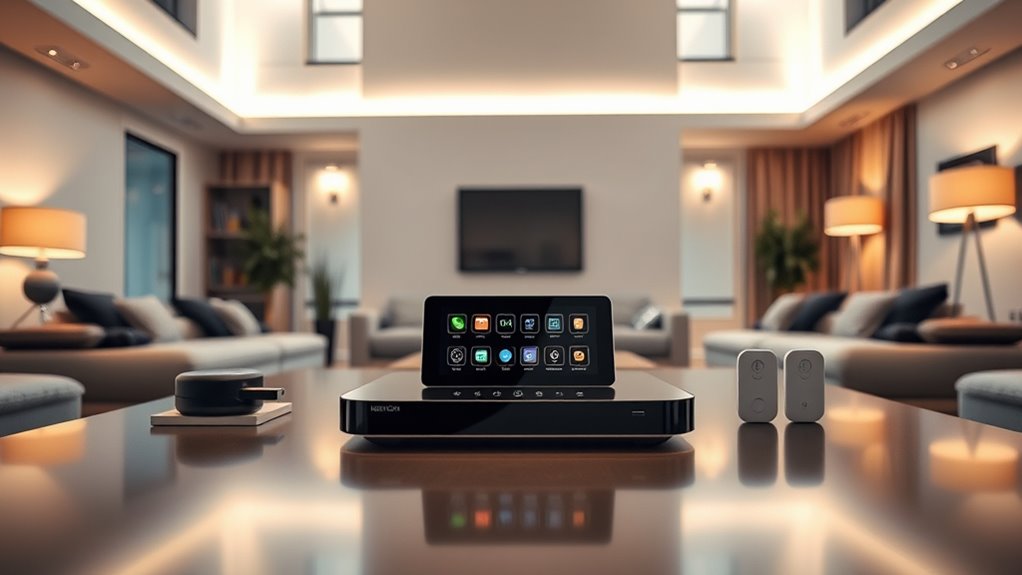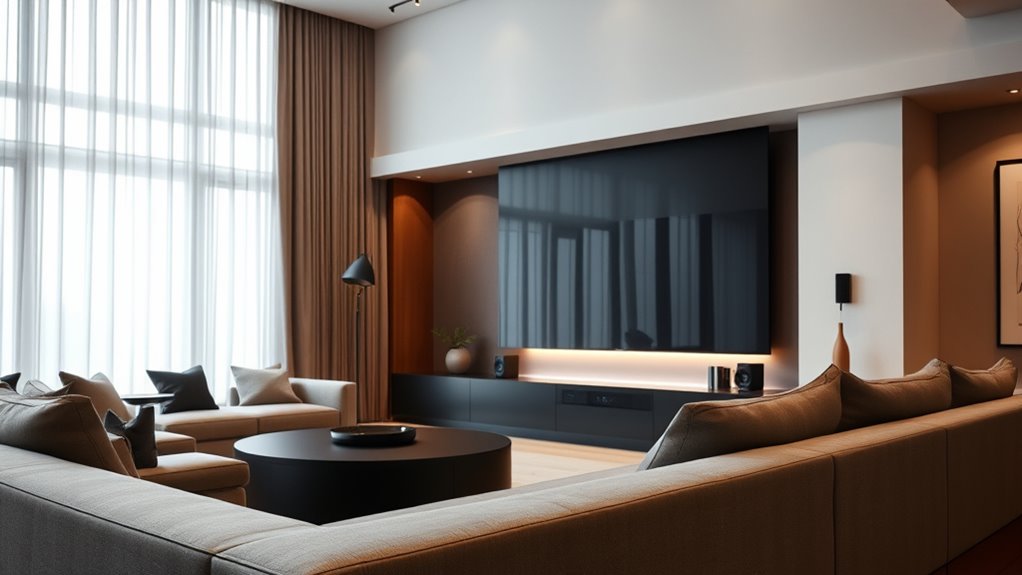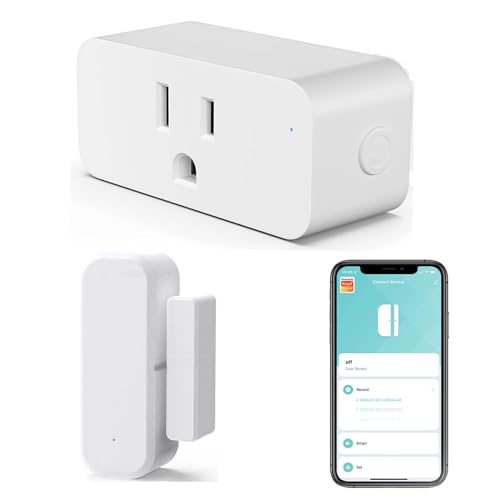If you’re looking for the top premium home automation hubs in 2025 that blend power and style, I’ve found options like the Homey Pro, Hubitat Elevation, and SmartThings Hub, all supporting multiple protocols like Zigbee, Z-Wave, Wi-Fi, and Matter. These hubs offer robust device compatibility, local processing for privacy, sleek designs, and advanced automation features. Stay with me, and I’ll guide you through the best choices to upgrade your smart home effortlessly.
Key Takeaways
- Top-tier hubs like Homey Pro and Hubitat Elevation offer extensive device compatibility, multi-protocol support, and robust local processing for reliable automation.
- Premium options blend advanced energy monitoring, customizable routines, and fast response times with sleek, modern designs for an elegant smart home experience.
- These hubs prioritize privacy and security through local data processing, encryption, and seamless integration with ecosystems like Apple HomeKit and Matter.
- Devices such as Otto-Premium and MOES ZigBee provide versatile control, remote management, and long-range mesh networking with stylish aesthetics.
- Future-proof features include support for emerging standards like Matter and broad ecosystem compatibility, ensuring power and elegance in 2025.
Homey Pro Smart Home Hub for Automation
If you’re looking for a smart home hub that offers unmatched device compatibility and seamless integration, the Homey Pro is a top choice. It supports over 50,000 devices from more than 1,000 brands, like Sonos, Philips Hue, and Yale, ensuring you can connect nearly everything. Its open platform allows for easy addition of new devices and custom apps. The hub uses seven protocols—Wi-Fi, Zigbee, Z-Wave, Infrared, BLE, Matter, and Thread—ensuring reliable, broad compatibility. With local processing, it minimizes cloud dependence, boosting privacy and stability. Control everything remotely via the app, create custom routines, and enjoy energy-saving automation all in one powerful device.
Best For: smart home enthusiasts seeking extensive device compatibility, local processing, and customizable automation in a reliable, privacy-focused hub.
Pros:
- Supports over 50,000 devices from more than 1,000 brands, ensuring broad compatibility
- Utilizes seven protocols (Wi-Fi, Zigbee, Z-Wave, Infrared, BLE, Matter, Thread) for reliable connectivity
- Local processing minimizes cloud dependency, enhancing privacy and stability
Cons:
- Initial setup and configuration can be complex for beginners
- May require additional hubs or bridges for certain devices or advanced features
- Pricing might be higher compared to simpler or less versatile smart hubs
Hubitat Elevation Home Automation Hub (Model C-8 Pro)
The Hubitat Elevation C-8 Pro stands out as an excellent choice for advanced home automation enthusiasts who prioritize local control, privacy, and extensive device compatibility. It supports over 1,000 devices from 100+ brands, including Aqara, Philips Hue, Nest, and Lutron, using protocols like Zigbee 3.0, Z-Wave 800, Wi-Fi, IR, and Matter. All data is processed locally, ensuring faster, more reliable responses and enhanced privacy, even during internet outages. Its automation capabilities are extensive, from scheduling to complex rules, making it ideal for customizing lighting, security, and energy management. While setup can be technical, the active community and robust performance make it a top-tier, independent hub for serious smart home users.
Best For: advanced home automation enthusiasts who value local control, privacy, and extensive device compatibility across multiple protocols.
Pros:
- Supports over 1,000 devices from 100+ brands with multiple protocols including Zigbee 3.0, Z-Wave 800, Wi-Fi, IR, and Matter.
- Processes all data locally, ensuring fast response times, increased reliability, and enhanced privacy.
- Offers extensive automation capabilities for complex rules, scheduling, and custom integrations, suitable for sophisticated smart home setups.
Cons:
- Setup can be technically challenging, requiring some knowledge and troubleshooting, especially for Zigbee network configuration.
- Mobile app and user interface are sometimes considered less intuitive and more regressive.
- No free remote management plan; remote access requires a paid subscription, which may be a drawback for some users.
Homey Bridge Smart Home Hub for Automation
Looking for a versatile smart home hub that seamlessly integrates multiple protocols and supports extensive device compatibility? The Homey Bridge is exactly that. It supports Z-Wave Plus, Zigbee, Wi-Fi, BLE, and Infrared, working effortlessly with thousands of top brands like Philips Hue, Sonos, Nest, and IKEA. You can control devices via voice commands through Alexa, Google, or Siri Shortcuts. With custom automation flows in the app, routines become simple to set up, such as playing music when you arrive home. Built with privacy in mind, it ensures your data stays secure. A free trial of Homey Premium adds extra features for more connected devices.
Best For: homeowners seeking a versatile, privacy-conscious smart home hub that supports multiple protocols and extensive device compatibility for seamless automation and voice control.
Pros:
- Supports a wide range of protocols including Z-Wave Plus, Zigbee, Wi-Fi, BLE, and Infrared for comprehensive device integration
- Enables custom automation flows and voice control through Alexa, Google, and Siri Shortcuts for enhanced convenience
- Built with a strong emphasis on privacy and data security, ensuring user data is not shared or used for profiling without consent
Cons:
- Requires a subscription ($2.99/month) for connecting more than five devices, which may add ongoing costs
- Compatibility verification with specific devices must be done via the Homey App Store, potentially complicating setup for some users
- May necessitate device-specific configurations or additional accessories for certain integrations or advanced automation features
SmartThings Hub 3rd Gen Home Automation Hub
For homeowners seeking a versatile and reliable central hub, the SmartThings Hub 3rd Gen stands out by supporting Zigbee, Z-Wave, and cloud-to-cloud protocols, making it compatible with a wide range of smart devices. Its compact design, measuring just 5 inches square, fits seamlessly into any space, while offering easy setup via QR code. The hub works with platforms like SmartThings, Alexa, and Google Assistant, enabling effortless automation. Battery-powered with optional Ethernet and Wi-Fi connectivity, it ensures dependable performance. Users praise its stability and device integration, though initial setup can be tricky. Overall, it’s a powerful, elegant option for centralizing your smart home ecosystem.
Best For: homeowners seeking a versatile, reliable, and easy-to-integrate central hub for smart home automation with broad device compatibility.
Pros:
- Supports Zigbee, Z-Wave, and cloud-to-cloud protocols for extensive device compatibility
- Compact design with easy setup via QR code and straightforward pairing process
- Reliable performance with stable connectivity, especially when using Ethernet
Cons:
- Initial setup can be challenging for some users, requiring careful following of instructions
- Occasional device disconnects or offline sensors may occur without troubleshooting
- Troubleshooting sensor reset procedures can be confusing due to small pins and complex steps
Philips Hue Bridge, Smart Lighting Hub with Automation and Voice Control
If you want a smart lighting system that seamlessly integrates with your entire home setup, the Philips Hue Bridge is an excellent choice. It supports up to 50 lights and accessories, revealing the full potential of your smart lighting. The Bridge uses Zigbee technology for a secure, stable connection that works even if your Wi-Fi goes down. You can control your lights remotely via the Hue app, create zones, and automate scenes. Plus, it’s compatible with voice control and Matter devices, making it future-proof. Whether for everyday convenience or immersive entertainment, this hub offers reliable, customizable lighting that elevates your smart home experience.
Best For: anyone seeking a reliable, expandable smart lighting system that integrates seamlessly with their home automation setup and offers advanced control features.
Pros:
- Supports up to 50 lights and accessories for extensive customization
- Uses Zigbee technology for a secure and stable connection independent of Wi-Fi
- Compatible with voice control and Matter devices for future-proof smart home integration
Cons:
- Requires a separate Hue Bridge hub, adding to initial setup cost
- Limited to Philips Hue ecosystem unless integrated with other Matter-compatible devices
- Setup may be complex for users unfamiliar with smart home technology
Emporia Vue 3 Home Energy Monitor
The Emporia Vue 3 Home Energy Monitor stands out as an ideal choice for homeowners seeking detailed, real-time energy insights and cost-saving automation. Certified with UL standards, it ensures safety and reliability, supporting a variety of system configurations. With sixteen 50A branch sensors, it provides granular data on critical loads like appliances and HVAC systems, all accessible through a user-friendly app. Its automation features allow for customized energy management, helping users reduce bills and optimize usage. Installation is straightforward within the breaker panel, and its compatibility with smart plugs expands monitoring capabilities. Overall, the Vue 3 offers precise energy tracking combined with safety and convenience.
Best For: homeowners seeking detailed real-time energy monitoring, cost-saving automation, and safety-certified installation within their electrical panels.
Pros:
- Provides granular energy data for multiple critical loads with sixteen 50A sensors.
- Certified UL safety standards ensure reliable and safe operation.
- User-friendly app supports automation, real-time alerts, and data export for comprehensive energy management.
Cons:
- Installation requires working within the breaker panel, which may be challenging for some users.
- Signal strength and panel space limitations can affect optimal device performance.
- External sensors and accessories are sold separately, adding to overall cost.
MOES ZigBee 3.0 Hub/Wired Gateway for Smart Homes
The MOES ZigBee 3.0 Hub/Wired Gateway stands out as an excellent choice for smart home enthusiasts seeking reliable and seamless ZigBee device integration. Its compact design, powered via USB, makes placement easy, while its stable connectivity covers over 200 meters. Compatible with Tuya ZigBee devices and platforms like Alexa and Home Assistant, it simplifies setup and control of lights, sensors, and switches. Although limited in compatibility with some products and featuring bright LED indicators, the hub offers dependable performance and Ethernet support for network stability. Priced around $60, it’s a solid, budget-friendly option for expanding your smart home ecosystem within the Tuya/Moes environment.
Best For: smart home enthusiasts seeking a reliable, easy-to-setup ZigBee hub compatible with Tuya devices and platforms like Alexa and Home Assistant.
Pros:
- Compact design with USB power for flexible placement
- Reliable ZigBee connectivity over distances exceeding 15 meters
- Supports Ethernet connection for enhanced network stability
Cons:
- Limited compatibility with some ZigBee products and proprietary protocol restrictions
- Bright LED indicators with no option to disable, which may be disruptive at night
- Slightly higher price point around $60 compared to some alternatives
For homeowners seeking effortless control over their smart devices, the arre Smart Button with Matter and Thread support stands out as an excellent choice. It seamlessly integrates with Apple HomeKit and Samsung SmartThings, ensuring broad compatibility. Certified with the Matter protocol, it offers reliable interoperability across leading ecosystems. Its Thread-enabled technology provides faster, low-latency communication, though it requires a Thread Border Route for ideal performance. The button supports multiple press types—single, double, and long press—allowing versatile control. Plus, you can personalize its appearance with decorative stickers, including glow-in-the-dark options, making it both functional and stylish.
Best For: homeowners seeking versatile, reliable, and customizable smart home control solutions compatible with major ecosystems.
Pros:
- Seamless integration with Apple HomeKit and Samsung SmartThings for broad ecosystem compatibility
- Supports multiple press types (single, double, long press) for versatile device control
- Personalization options with decorative stickers, including glow-in-the-dark choices
Cons:
- Requires a Thread Border Route for optimal operation, adding setup complexity
- Limited to specific ecosystem integrations, which may not suit all smart home setups
- May need additional accessories or hubs for full functionality in some environments
Kasa Smart Plug HS103P4, Wi-Fi Outlet, 4-Pack
If you’re looking to upgrade your smart home setup with reliable, Wi-Fi-enabled outlets, the Kasa Smart Plug HS103P4 4-pack stands out as an excellent choice. These outlets require no hub, work seamlessly with Alexa, Google Assistant, and IFTTT, and support a 15 Amp load for versatile use. Easy to set up through the user-friendly Kasa app, you can control your devices remotely from anywhere and create schedules or timers for automation. UL certified for safety and trusted by over 5 million users, this pack offers a cost-effective, reliable way to automate lamps, fans, or holiday lights effortlessly.
Best For: those seeking a reliable, easy-to-use smart plug solution to automate their home appliances without the need for a hub.
Pros:
- Compatible with Alexa, Google Assistant, and IFTTT for seamless voice and app control
- Easy setup via the free Kasa app with remote access from anywhere
- UL certified for safety and supporting up to 15 Amp loads
Cons:
- Only supports 2.4GHz Wi-Fi networks, not compatible with 5GHz networks
- Limited to basic scheduling and timer features without advanced automation options
- Requires a stable Wi-Fi connection for optimal operation
Otto-Premium Smart Assistant with Voice Control and Ai Automation
Anyone seeking a sleek, all-in-one home automation hub will find the Otto-Premium Smart Assistant especially appealing, as it combines AI-driven automation, voice control, and multi-room connectivity in a modern design. Crafted with velvet fabric and a metal frame, it measures 22.8 inches deep and 33.46 inches wide, adding a stylish touch to any space. It responds effortlessly to voice commands, learns routines, and automates lighting, temperature, and security. Compatible with popular platforms like Alexa and smart bulbs, it optimizes energy use based on occupancy and schedules. Easy to set up and expand, it offers advanced features in a minimalist aesthetic, making smart living simple and elegant.
Best For: homeowners and tech enthusiasts seeking a sleek, all-in-one smart home hub that effortlessly integrates automation, voice control, and multi-room connectivity with modern design.
Pros:
- Seamless integration with popular platforms like Alexa and smart bulbs for versatile control
- Elegant minimalist design with high-quality velvet fabric and metal frame that enhances modern interiors
- Energy-efficient automation that reduces utility bills by adjusting devices based on occupancy and schedules
Cons:
- Requires assembly which may be challenging for some users
- Supports a maximum weight of 27.6 pounds, limiting heavier devices or appliances
- Availability and pricing are subject to change; consumers should monitor for competitive deals
SofaBaton X1S Universal Remote with Hub and App
The SofaBaton X1S Universal Remote with Hub and App stands out for its ability to control over 60 device types from more than 6,000 brands, making it an excellent choice for tech enthusiasts who want a centralized solution. It features a powerful hub with 360-degree control, two IR blasters, and stable signals, allowing control from anywhere in the room without aiming. The remote offers extensive customization with macros and activities, plus integration with smart apps like IFTTT. Despite some setup challenges and limited Bluetooth support, it delivers reliable performance, voice control, and a sleek design, making it a versatile addition to any advanced home automation system.
Best For: tech-savvy home automation enthusiasts seeking a highly customizable universal remote with extensive device compatibility and automation features.
Pros:
- Supports control of over 60 device types from 6,000+ brands with a comprehensive database.
- Offers advanced customization options, macros, and activity chaining for simplified routines.
- Features a powerful hub with 360-degree control, stable signals, and voice command integration.
Cons:
- Setup process can be complex and lacks beginner-friendly guidance.
- Limited Bluetooth support for certain Bluetooth-only devices, leading to compatibility issues.
- App interface and support are sometimes confusing and not very user-friendly.
SOLO WiFi Door/Window Sensor with App Alerts and Alexa Compatibility
The SOLO WiFi Door/Window Sensor stands out for its real-time alerts and app management, making it an ideal choice for those seeking reliable home security without complex setups. It sends instant notifications via the Smartlife App (Tuya platform) whenever a door or window opens or closes, allowing me to check event history and battery status easily. Its versatile design lets me install it on front doors, windows, safes, or even pet doors, enhancing safety. With compatibility for Alexa and Google Home, I can control it via voice or automate actions like turning smart plugs on or off. No hub needed—just WiFi—and it’s built with sturdy, durable materials.
Best For: homeowners seeking easy-to-install, WiFi-connected door/window sensors with real-time alerts and voice control integration.
Pros:
- Instant notifications via Smartlife App for quick security updates
- Compatible with Alexa and Google Home for seamless voice control and automation
- No hub required; connects directly to WiFi for simple setup and use
Cons:
- Requires a stable WiFi connection for optimal performance
- Limited to alerts and automation; does not include advanced security features like cameras
- Battery life may need frequent monitoring depending on usage and environmental factors
REOLINK Home Hub, Home Security System with Local Storage
For those seeking a reliable home security system that prioritizes local storage and seamless camera integration, the Reolink Home Hub stands out. It supports up to eight Reolink cameras and doorbells, offering centralized control, motion alerts, sirens, and event summaries without monthly fees. The hub includes a 64GB microSD card, expandable up to 1TB, ensuring your footage stays secure locally. Setup is simple, and it connects via Wi-Fi 6 for fast performance. While some users report connectivity issues in larger homes, its AES128 encryption and easy app control make it a solid, privacy-focused choice for reliable security with local storage.
Best For: homeowners seeking a privacy-focused, easy-to-use home security system with local storage and seamless camera integration.
Pros:
- Supports up to 8 cameras and doorbells for centralized monitoring and control
- Local storage with expandable microSD slots up to 1TB ensures footage security without monthly fees
- Easy setup with Wi-Fi 6 connectivity and app control, plus AES128 encryption for privacy
Cons:
- May experience connectivity issues or Wi-Fi disconnections in larger or complex homes
- Firmware updates and compatibility with certain cameras can be challenging or require support assistance
- Limited Wi-Fi range without extenders or additional network adjustments
Lockin Wi-Fi Gateway and Electronic Lock Component for Smart Lock and Wireless Lock Box
Looking to upgrade your smart lock system with reliable, seamless connectivity? The Lockin Wi-Fi Gateway is designed to do just that. It supports devices like the Q3/Q1 Smart Door Knob and L1 Smart Box, allowing multiple device pairing for flexible management. Setup is quick—plug it in, connect via the app within two minutes, and keep the lock within 10 feet for stable performance. You can remotely control your lock from anywhere, manage access codes, and monitor lock status, battery life, and activity logs in real time. This enhances security, convenience, and peace of mind, making your smart lock system more reliable and secure.
Best For: homeowners and property managers seeking a reliable, easy-to-install Wi-Fi gateway to enhance their smart lock system with remote control and security monitoring.
Pros:
- Supports multiple compatible devices like Q3/Q1 Smart Door Knob and L1 Smart Box for flexible management
- Quick setup within two minutes and stable connection within 10 feet for reliable performance
- Enables remote access, code management, and real-time monitoring of lock status and activity logs
Cons:
- Not compatible with Lockin Veno series locks
- Requires a stable Wi-Fi connection for optimal performance
- Limited to devices that support the specific smart lock models mentioned
SONOFF Zigbee 3.0 USB Dongle Plus Gateway
If you’re seeking a reliable Zigbee hub that offers seamless integration with popular home automation platforms, the SONOFF Zigbee 3.0 USB Dongle Plus Gateway stands out as a top choice. Compatible with Home Assistant, IoBroker, and Zigbee2MQTT, it’s pre-flashed with Z-Stack 3.x.0 firmware for easy setup. Built on TI CC2652P hardware, it features an external SMA antenna for better range and reduced interference. Small and lightweight, it connects effortlessly via USB, supporting mesh networks with various Zigbee devices. Highly rated for reliability and ease of use, it’s a cost-effective, versatile solution for enhancing your smart home.
Best For: home automation enthusiasts seeking a reliable, easy-to-set-up Zigbee hub compatible with platforms like Home Assistant and Zigbee2MQTT.
Pros:
- Plug-and-play setup with quick device detection and stable connections
- Compatible with multiple Zigbee devices and supports mesh networking
- Compact, lightweight design with external antenna for improved range and reduced interference
Cons:
- Firmware flashing can be complex and may require troubleshooting or updates
- Initial setup issues reported by some users, especially with firmware or device recognition
- Optimal performance often requires USB extension cables to improve signal and reduce interference
Factors to Consider When Choosing Premium Home Automation Hubs

When selecting a premium home automation hub, I consider factors like device compatibility and protocol support to guarantee I can connect all my gadgets seamlessly. I also look at local processing power and automation flexibility so I can customize routines without lag. Ultimately, privacy protections are vital to keep my data secure while enjoying smart home convenience.
Device Compatibility Range
Choosing a premium home automation hub requires careful consideration of its device compatibility range, as this directly impacts how seamlessly your smart home functions. A versatile hub should support multiple protocols like Zigbee, Z-Wave, Wi-Fi, Bluetooth, and Thread to guarantee it works with diverse devices. Compatibility with popular ecosystems such as Apple HomeKit, Google Home, and Amazon Alexa further enhances integration options. I look for hubs that can connect with over 50,000 devices from more than 1,000 brands, making my system both versatile and future-proof. Support for emerging standards like Matter is also essential, as it assures interoperability across different manufacturers and ecosystems. Finally, a broad device compatibility range allows me to automate lighting, security, energy, and entertainment effortlessly, creating a truly integrated smart home.
Protocol Support Variety
A key factor in selecting a premium home automation hub is its support for multiple protocols, which determines how well it communicates with various devices. A versatile hub should handle Zigbee, Z-Wave, Wi-Fi, Bluetooth, and infrared, ensuring broad compatibility. Supporting emerging standards like Matter is essential, as it promotes interoperability across different brands and ecosystems, future-proofing your setup. Multi-protocol hubs also enable local processing and control, reducing dependence on cloud services and boosting reliability. While proprietary protocols such as MOES ZigBee or Tuya ZigBee can expand device options, they may limit cross-brand compatibility. Ultimately, a hub that seamlessly integrates multiple protocols allows for smoother automation, better device communication, and a unified smart home experience.
Local Processing Power
Robust local processing power is essential because it determines how quickly and reliably your home automation hub can execute commands without relying on the internet. A powerful processor enables the hub to handle complex routines and respond to real-time sensor data independently, ensuring smooth operation even during internet outages. High processing capacity also supports seamless integration of multiple protocols and numerous devices, reducing lag and enhancing system stability. This means automation rules and scene triggers activate instantly, providing a better user experience and increased security. Conversely, hubs with limited processing power may experience delays or failures, forcing reliance on cloud services that can compromise privacy and reliability. Investing in a hub with strong local processing ensures your smart home runs efficiently, securely, and without interruption.
Automation Flexibility
To maximize your smart home’s potential, it’s crucial to prioritize automation flexibility when selecting a home automation hub. A versatile hub should support multiple protocols like Zigbee, Z-Wave, Wi-Fi, and Thread, ensuring seamless integration of various devices. The ability to create complex routines and custom workflows gives you tailored control over your home environment. Compatibility with popular voice assistants and smart ecosystems enhances convenience through voice activation and scene triggers. Additionally, support for community-developed apps and custom scripts expands automation possibilities beyond default features, fostering innovation. An open platform that allows firmware updates, device additions, and protocol integration helps your hub evolve with new technologies and changing needs. Flexibility is key to a truly dynamic and personalized smart home experience.
Privacy Protections
Since privacy is a top concern, choosing a premium home automation hub that emphasizes data protection is essential. I look for hubs that process data locally whenever possible, reducing reliance on cloud services and minimizing exposure. Robust security features like encryption and user-controlled access permissions are *crucial* to keep personal information safe. I prefer hubs that don’t share data with third parties unless I explicitly authorize it, ensuring I stay in control of my information. Advanced authentication methods, like multi-factor authentication, add an extra layer of protection against unauthorized access. Additionally, regular firmware updates from manufacturers are *vital*, as they patch security vulnerabilities and maintain system integrity. Prioritizing these privacy protections helps me enjoy a secure, private smart home environment without sacrificing convenience.
Integration Ease
When choosing a premium home automation hub, ease of integration is key to creating a seamless smart home experience. A great hub should support multiple protocols like Zigbee, Z-Wave, Wi-Fi, and Thread, ensuring compatibility with a wide range of devices. User-friendly setup processes, such as QR code scanning or app-guided instructions, make installation straightforward without technical expertise. Compatibility with popular voice assistants like Alexa, Google Assistant, and Siri Shortcuts allows for effortless control and automation. Support for standards like Matter simplifies device pairing and boosts interoperability among different brands. Robust integration solutions enable me to link devices, create routines, and customize workflows easily, making my smart home more responsive, flexible, and intuitive.
Network Stability
A stable home automation hub is essential for reliable device communication and a seamless smart home experience. It ensures consistent signals, reducing disconnections and delays that can disrupt automation. Multi-protocol support, like Zigbee, Z-Wave, and Wi-Fi, helps avoid interference and congestion, boosting network reliability. Regular firmware updates and network optimization, such as using Ethernet connections, keep the system responsive and secure. Proper placement of the hub—away from Wi-Fi congestion sources and physical obstructions—significantly improves signal strength. Additionally, incorporating network extenders or mesh systems helps extend coverage, ensuring all devices stay connected. Prioritizing these factors guarantees a resilient, stable network, allowing your smart home to operate smoothly without hiccups or interruptions.
Future-Proof Features
Choosing a premium home automation hub that is future-proof guarantees your smart home remains adaptable and secure as technology evolves. Support for emerging protocols like Matter ensures seamless integration with new devices, preventing obsolescence. Compatibility with multiple standards such as Zigbee, Z-Wave, Thread, and Wi-Fi allows the hub to adapt to changing smart home ecosystems. Automatic firmware and software updates keep security patches and features current without hardware replacements. Integration with voice assistants and automation platforms that are continually updated ensures ongoing interoperability and convenience. Additionally, modular or open-platform hubs let you add or upgrade components over time, extending their lifespan and functionality. Investing in future-proof features means your smart home stays modern, secure, and flexible for years to come.
Frequently Asked Questions
How Do Premium Hubs Ensure Security and Data Privacy?
Premium hubs guarantee security and data privacy by using advanced encryption protocols, like AES-256, to protect my data in transit and at rest. I appreciate their regular firmware updates that patch vulnerabilities, and multi-factor authentication adds an extra layer of protection. Additionally, they often feature local processing options, so sensitive info doesn’t always need to leave my home network, giving me peace of mind.
Can These Hubs Integrate With All Existing Smart Devices?
Think of these hubs as the central nervous system of your smart home. They’re designed to work seamlessly with most devices, but not necessarily all. I’ve found that premium hubs often support major brands and protocols, making integration smooth. However, compatibility can vary, so I recommend checking each hub’s device list. This way, I make certain my smart devices communicate effortlessly, creating a cohesive and intelligent living space.
What Is the Typical Setup Time for Top-Tier Automation Hubs?
Setup times for top-tier automation hubs usually range from 30 minutes to a couple of hours. I find that it depends on how many devices you’re connecting and the complexity of your system. Typically, I recommend allocating some extra time for firmware updates and troubleshooting. Just make sure you follow the manufacturer’s instructions carefully, and you’ll have your smart home up and running smoothly in no time.
How Do Hubs Handle Software Updates and Firmware Management?
I’ve found that top-tier hubs handle updates smoothly, often automatically downloading and installing firmware during off-peak hours. This means I don’t have to worry about manual updates interrupting my setup. Plus, they usually notify me beforehand and let me schedule updates at convenient times. This seamless management keeps my system secure and up-to-date without any hassle, so I can focus on enjoying my smart home.
Are Premium Hubs Future-Proof for Upcoming Smart Technology Standards?
Yes, premium hubs are designed with future-proofing in mind. They often support multiple protocols and are built to be compatible with upcoming standards, meaning I don’t have to worry about obsolescence anytime soon. Manufacturers frequently update their firmware to guarantee continued compatibility, so I can enjoy new smart features without replacing my hub. This ongoing support gives me confidence that my home automation system will evolve with technology.
Conclusion
Choosing the right premium home automation hub blends power with elegance, convenience with sophistication. It’s about balancing seamless control with sleek design, ensuring your smart home feels intuitive yet refined. Whether you prioritize security, lighting, or overall automation, these hubs offer the best of both worlds. In the end, it’s not just about tech—it’s about creating a space that’s both beautiful and intelligent, where innovation meets effortless living.






![SmartThings Hub 3rd Generation [GP-U999SJVLGDA] Smart Home Automation Hub Home](https://m.media-amazon.com/images/I/21hChu0ounL._SL500_.jpg)



















